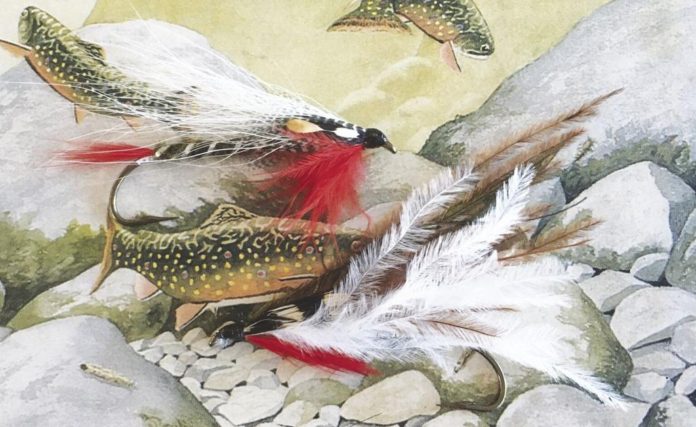It appears that spring fishing will get an early start this year. Snowpack is down and spring temperatures are right around the corner. Planning of early spring fishing trips are in full swing. One of those trips is planning to head over to the Magalloway watershed in pursuit of big brook trout.
The Magalloway is the last bastion of heritage strain river run brook trout in New Hampshire. There are special regulations on the river. These regulations include single barless hooks on flies or lures and catch and release. These regulations ensure that New Hampshire will continue to have river run brook trout measured in pounds, not inches.
Whenever planning a special trip, I try and place myself in the shoes of the early anglers. These anglers were astute observers of all that nature surrounded them with. They developed flies, using trial and error, that best imitated natural foods or were attractors to get the fish to strike.
There are many tried and true fly patterns that are cast to the Magalloway River brook trout. Gray Ghost. Black Ghost. Mickey Finn. Little Brook Trout Bucktail. The fish have seen these flies throughout their lives and are not easily fooled.
In preparation of the Magalloway trip, I headed to my trusty streamer fly reference. “Streamer Fly Tying & Fishing” by Joseph D. Bates is loaded with old time, long forgotten streamer fly patterns. I knew I would be able to find some flies in the book that while old patterns, would be new to the brook trout.
The third streamer fly listed in the book was the Anson Special Bucktail. According to the description under the fly recipe the Anson Special Bucktail was “originated by Mr. Anson Bell, an old time logger in the lumber camps of Maine and particularly on the Magalloway River in Maine and New Hampshire.”
The recipe for the fly was elegant. A true attractor pattern. Red hackle for the tail and the throat. Peacock herl for the body. Silver tinsel for the tip and the ribbing. White bucktail for the wing. Barred teal for the cheek. Jungle cock for the eye. Any fly with jungle cock is a fly I want to tie!
Three pages later, was a second Fly created by Mr. Bell. The Bell Special Streamer was simplicity in itself. A body of silver tinsel. Three red hackle tips for the throat. White ostrich herl, then brown ostrich herl, then four peacock herl for the wing. Jungle cock for the eye. This is the only trout streamer I have seen that uses ostrich herl for the wing. Surely, the brook trout don’t see ostrich herl very often. This fly must have been Mr. Bell’s bait fish imitation.
Under both fly descriptions in the book is the following, “The fly is popular for taking all species of trout, particularly in New York State and New England.”
These flies may have been popular 50 years ago. You will be hard pressed to find these flies in fly shops today.
Pulling the necessary materials from my supplies, I got to work. I am fortunate to have some Mustad 36675 barbless streamer hooks in size 8. A little small for the brook trout on the Magalloway River but perfect size for the ponds in that watershed. I would tie larger flies on Mustad 9575 hooks, size 2, and pinch the barbs. If you want to catch big fish, you need to cast big flies!
The flies are gorgeous. The ice can’t leave the Magallowy River soon enough. Can you say “road trip?”
If you don’t have ostrich herl, use some synthetic wing material like Fishair or craft fur. I’m sure Anson Bell would approve.
Steve Angers, a native to the Conway area, is the author of the book “Fly Fishing New Hampshire’s Secret Waters” and operates the North Country Angler.
Credit: Source link






























